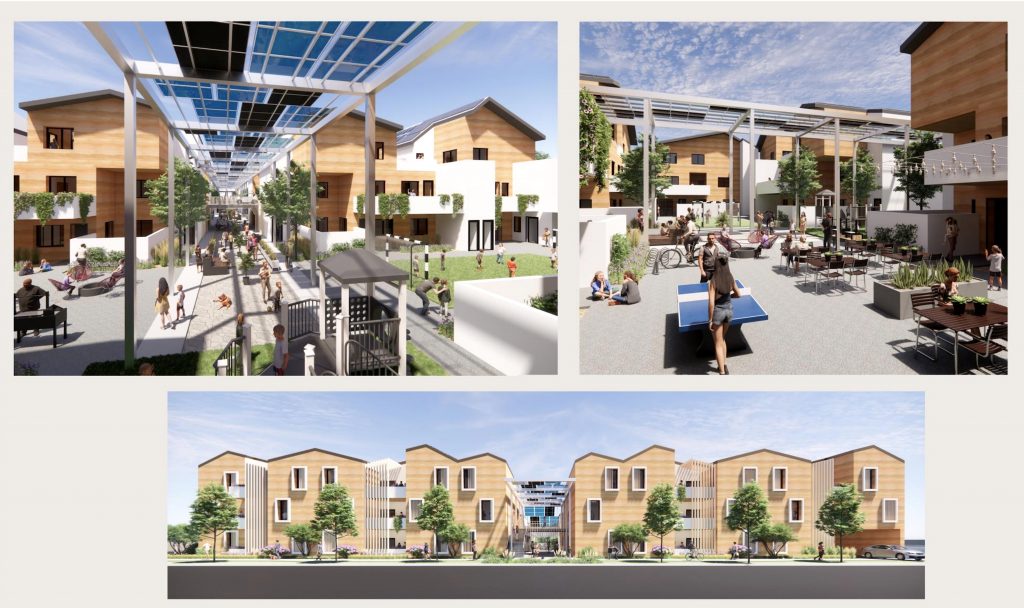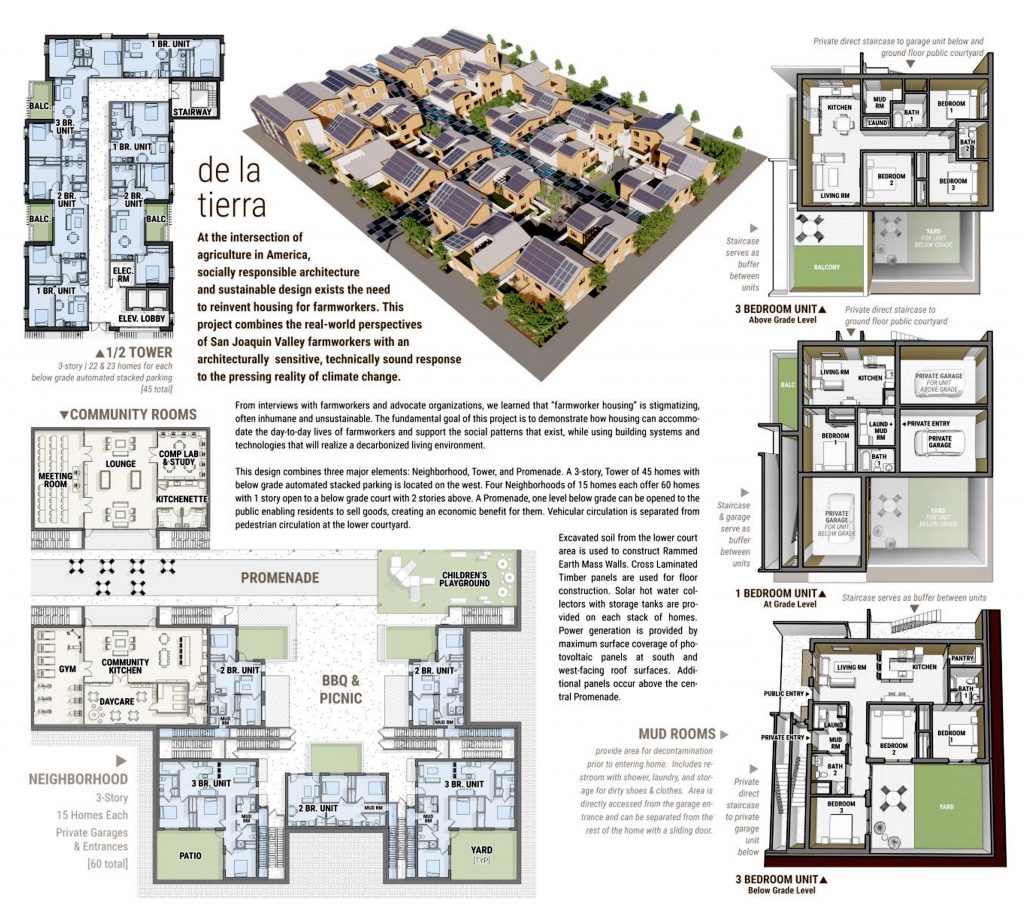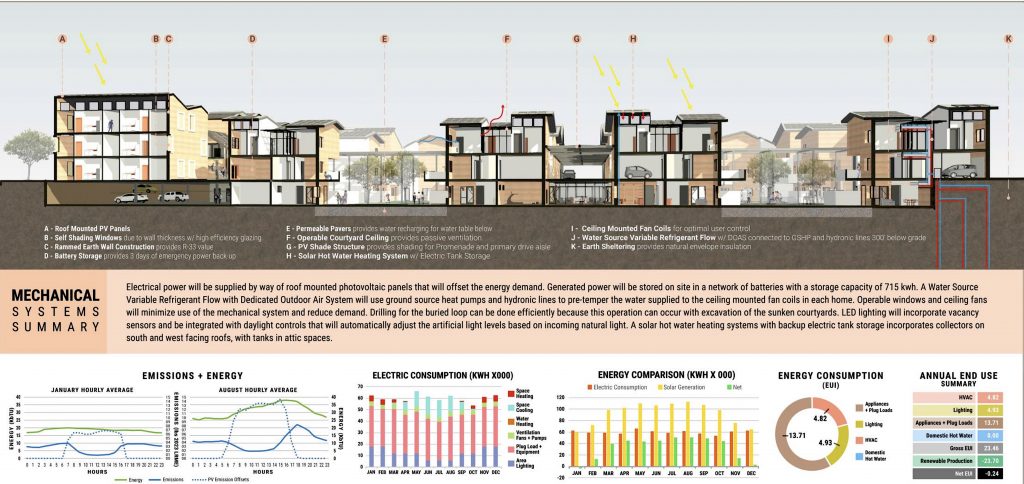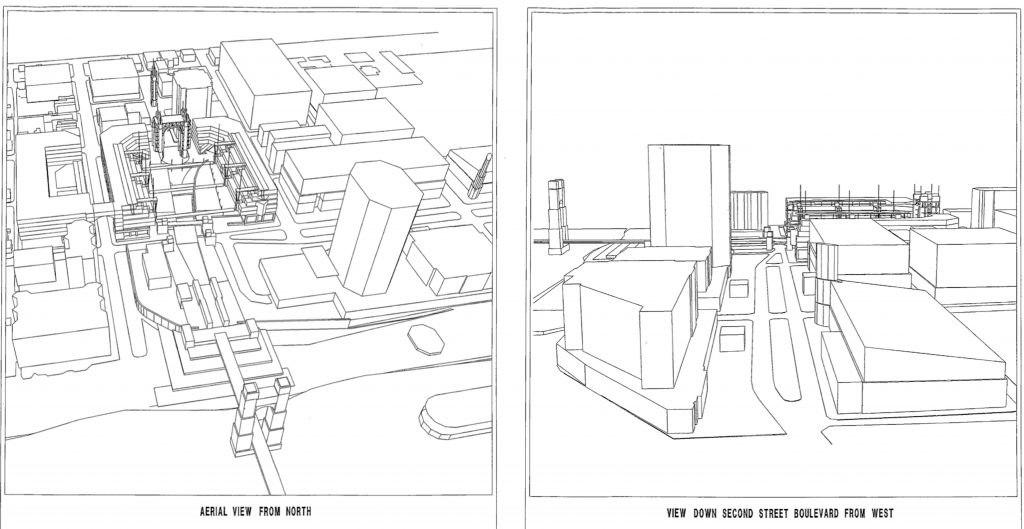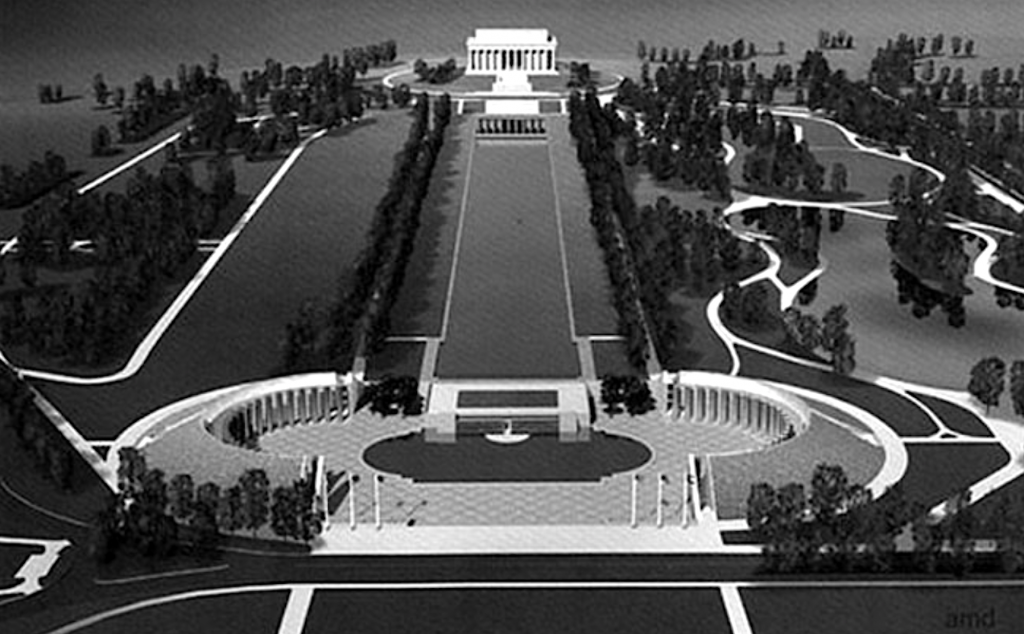
2023 Teaching and Innovation Farm Lab Graduate Student Honor Award by USC (aerial view)
Architecture at Zero competitions, which focus on the theme, Design Competition for Decarbonization, Equity and Resilience in California, have been supported by numerous California utilities such as Southern California Edison, PG&E, SoCAl Gas, etc., who have recognized the need for better climate solutions in that state as well as globally. Until recently, most of these competitions were based on an ideas only format, with few expectations that any of the winning designs would actually be realized. The anticipated realization of the 2022 and 2023 competitions suggests that some clients are taking these ideas seriously enough to go ahead with realization.
Here it should be noted that a state grant of $40M to help support projects of this nature in the Valley resulted in a logical institutional fit, both for organizing a design competition, as well as carrying through the idea to its ultimate completion. The 2021-22 Architecture at Zero competition, which focused on housing for farm workers in California’s Central Valley, awarded a commission to Fresno based Paul Halajuan Architects, one of three highly ranked firms receiving a “merit award” in that competition.
The more recently completed 2023 competition focused on the design of a Teaching & Innovation Farm Lab, located in the Central Valley, north of Bakersfield. The latest news concerning that project, released by the Allensworth Progressive Association (APA), is that several of the Professional and Student teams from the competition have been interviewed to discuss their entries in more detail. At this stage the APA is concentrating on refining the building program and developing a fundraising plan. Since the client already has been promised $12 million for implementation of the project, one might assume that additional funding is intended to secure the stability of the project well into the future.
The 2021/22 Net Zero Competition
Farmworker’s housing in California has long been either substandard or very high density—when available at all. So a competition for the design of housing incorporating some of the most essential features, I.e., decarbonization, comfort, etc. was well overdue. Self Help Enterprises of Visalia, California stepped in to support the competition, which was administered by Architecture at Zero.
The proposed program asked for 105 new units of affordable housing, for farmworkers and their families. Unit size and composition: 37 units to be 3 bedroom (size range 900-1250 sq ft.) 37 units to be 2 bedroom (size range 700-850 sq ft.) 31 units to be 1 bedroom (size range 450-590 sq. ft.) Air conditioning was required and, according to residents, natural light in their living spaces was a high priority.
Betsy McGovern, Program Director of Real Estate Development stated: “Self Help Enterprises is delighted to participate in the 2021-22 Architecture at Zero competition and receive fresh ideas, thoughts and concepts that can be applied in Visalia and the surrounding San Joaquin Valley. There continues to be a huge demand for housing for farmworkers, and this is a unique opportunity to integrate decarbonization and climate resiliency through an equity lens.”
The competition jury was composed of:
• Lance Collins, AIA, Director at Partner Energy
• Mary Ann Lazarus, FAIA, Cameron MacAllister Group
• Paul Torcellini, PhD, Principal Engineer, NREL
• Allison G. Williams, FAIA, AGWms _studio
Competition adviser: Margie O’Driscoll
Merit Award*
Paul Halajuan Architects
Clovis, California
Unless otherwise noted, all above images courtesy: Architecture at Zero
[eme_events order=DESC limit=100 scope=future showperiod=monthly category=1]
[eme_events showperiod=monthly category=2]
One thing about competitions, and having the fortunate experience I’ve
had, I’ve really learned that being ambitious for your client and society
is hugely important. – James Cheng
This is Thursday, April 11, 2024, and I am in the office of emersion DESIGN with architect James Cheng and J.T. Spence, the latter the former planner of the City of Covington, Kentucky, who was responsible for initiating the Covington Gateway Competition in 1993, won by James Cheng. -Ed


Architect James Cheng (left) Prof. John T. Spence (right)
COMPETITIONS: A question I almost always start off with: At what point in your early life did you decide to become an architect?
James Cheng: It really all started when I was in junior high and high school and really loved my art classes. So I told my dad, who was a chemical engineer, that I wanted to become an artist, and he said, there is no way I’m going to pay for you to become an artist. He had just come back from New Orleans where he saw all these starving artists painting and trying to sell their paintings. So he suggested that I try architecture. We did have a family friend who was an architect. So he had me talk to him, and my dad then found a program for rising high school seniors at Cornell—a little like a summer camp for architecture. This happened to be a wonderful fit for me; but I would not have known about it otherwise at the time. Having been involved in the Arts community, such as the Contemporary Art Center, I can see how difficult an artist’s life is. So I feel really fortunate that I ended up in the architecture profession.
COMPETITIONS: After Cornell, was the Covington competition the first one one you ever entered?
JC: No, I believe I entered a competition for Spectacle Island with some friends; and then there was a small house competition.


Model of Covington Gateway competition winner ©James Cheng
COMPETITIONS: As for the Covington competition, besides our announcement of it, it was pretty well publicized, even internationally. At that time the National Endowment for the Arts had begun to support competitions and may have provided some support for the Covington competition.
J.T. Spence: Jeffry Ollswang (competition adviser) may have somehow been involved with that; but the City of Covington was responsible for the entire support of the competition. It was well publicized: we did posters and mailings, and we received 110 entries globally, from Australia, Japan and seven countries.
JC: I often went to the DAAP library (University of Cincinnati) and may have seen it in COMPETITIONS magazine there.
COMPETITIONS: We never met when you won the competition in Covington. But I was quite familiar with it as we had published an announcement about the competition in our magazine and I was present when the entries were set up for judging. I wondered that the Mayor of Covington never showed up for the events I attended, and thus thought this might be an unfortunate omen for the further development of the project.
JTS: That’s not as impactful as you might think, because Covington has a weak mayoral form of government. Moreover, our mayor had just returned from spending two weeks at the Mayors’ Institute of Design (in Washington) with its founder, Charleston Mayor, Joseph Riley. So he was very supportive of the idea of a competition. It was the other four elected officials that had no outward appreciation for what it meant. So I think they were less motivated to have the Mayor get credit for something in the city and (give the appearance of) diminishing their leadership role in the city.
COMPETITIONS: I was very aware of the mission of the Mayors’ Institute of Design. We were in continuous contact with the people who were running it at the time.
JTS: They gave us a very different vocabulary about what we were trying to get across to the elected officials, which was a vision of Covington’s future.



























